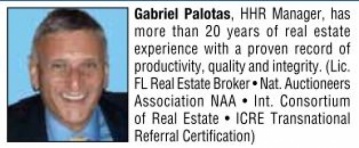
-Joanne Nearly, Fargo, ND
A: Adverse possession is in some ways similar to homesteading. Like the disseisor, the homesteader may gain title to property by using the land and fulfilling certain other conditions. In homesteading, however, the possession of the property is not hostile; the land is either considered to have no legal owner or is owned by the government.
Questions to gabepal@gmail.com or (954) 562-0110 to “Ask Gabe” in person.
The government allows the homesteader to use the land with the expectation the homesteader who fulfills the requirements necessary for the homestead will gain title to the property.
The principles of homesteading and squatter’s rights embody the most basic concept of property and ownership, summarized by the adage “possession is ninetenths of the law,” meaning the person who uses the property effectively owns it. Likewise, the adage, “use it or lose it,” applies. The principles of homesteading and squatter’s rights predate formal property laws; to a large degree, modern property law formalizes and expands these simple ideas.
The principle of homesteading is that if no one is using or possessing property, the first person to claim it and use it consistently over a specified period owns the property. Squatter’s rights embodies the idea that if one property owner neglects property and fails to use it, and a second person starts to tend and use the property, then after a certain period the first person’s claim to the property is lost and ownership transfers to the second person, who is actually using the property.
The essential ideas behind the principles of homesteading and squatter’s rights hold generally for any type of item or property of which ownership can be asserted by simple use or possession. In modern law, homesteading and the right of adverse possession refer exclusively to real property. In the realm of personal property, the same impulse is summarized by the adage “finders/keepers” and is formalized by laws and conventions concerning abandoned property.
Most cases of adverse possession deal with boundary line disputes between two parties who hold clear title to their property. The term “squatter’s rights” has no actual legal meaning, but is generally used to refer to a specific form of adverse possession where the squatters holds no title to any properties adjoining the property under dispute. In most jurisdictions of the United States, few squatters can meet the legal requirements for adverse possession.
If the squatter abandons the property for a period, or if the rightful owner effectively removes the squatter’s access even temporarily during the statutory period, or gives his permission, the “clock” usually stops. For example, if the required period in a given jurisdiction is twenty years and the squatter is removed after only 15 years, the squatter loses the benefit of that 15-year possession (i.e., the clock is reset at zero). If that squatter later retakes possession of the property, that squatter must, to acquire title, remain on the property for a full 20 years after the date on which the squatter retook possession. In this example, the squatter would have held the property for a total of 35 years (the original 15 years plus the later 20 years) to acquire title.
It is common practice in cities such as New York, where builders often leave sidewalk space or plazas in front of their buildings to meet zoning requirements, to close public areas they own periodically to prevent the creation of a permanent easement that would cloud their exclusive property rights. For the same reason, city sidewalks may have embedded markers along the property line around a plaza or open area announcing “This Space Not Dedicated” to indicate that although the public may use the space within the markers, it is still private property.
